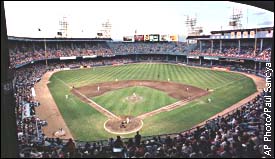
| ||||||||||||
| SPORTS NBA | ||||
Wednesday, September 22
A sad goodbye to the Tiger Stadium clubhouse
Special to ESPN.com

 | |
| After 87 years, the final game at Tiger Stadium will be played Monday. |
There are a lot of compelling stories this season, but none more so than Jim Morris, the pitcher who began the year as a high school science teacher and will end it as a Tampa Bay Devil Ray. Originally signed by the Brewers in 1983, Morris hurt his arm and retired as a player in 1989. But after his high school players dared him to try out for a major league team during the spring, he soon found himself signed again and beginning a swift trip through the minors and to a September callup last week. Then on Sept. 17, with his wife and children watching from the stands, Morris went to the mound, threw four pitches and struck out Rangers shortstop Royce Clayton. His line: .1 IP, 0 H, 0 R, 0 ER, 0 BB, 1 K Morris became the oldest rookie to make his major league debut since Minnie Mendoza played for the Twins at age 36 with the 1970 Twins (see chart below). Lies, damn lies and statistics
Kansas City rookie Mark Quinn hit as many home runs in his first seven games (five) as Otis Nixon has hit in his past seven years. ... Not only is Ivan Rodriguez just the eighth catcher to both score and drive in 100 runs during the same season, as the Philadelphia Inquirer's Jayson Stark points out, he also has stolen almost as many bases against opponents (24) as opponents have stolen against him (32). ... Cleveland fans beware: Winning the AL Central may not mean much. Your team was 10-21 against possible postseason opponents Boston, New York and Texas this season. Make it 11-23 if you include Houston (the only possible postseason opponent Cleveland had a winning record against was Cincinnati at 4-2). ... Atlanta pitchers have hit six home runs this year -- Greg Maddux 2, Kevin Millwood 1, John Smoltz 1 and Sean Bergman 2 (both when he was with Houston, however). ... When the Twins and the Mariners played at Safeco Field over the weekend, it marked the first time those two had played outside since 1981 at Minnesota's old Met Stadium. ... Rey Ordonez is right on pace. He hit one home run in 1996, one in 1997, one in 1998 and hit his first of the year this week. From left field
Morris may be an old rookie by today's standards, but during World War II and after the color barrier was lifted, there were a number of rookies in their mid-30s and beyond. Here is a list of rookies (albeit not necessarily definitive) who made their debuts at age 37 or older since the Depression era (age in years and months):
| AGE | PLAYER | YEAR | THE SKINNY |
| 42.00 | Satchel Paige | 1948 | Pitched three shutout innings at 59 in 1965 |
| 41.08 | Diomedes Olivo | 1960 | 0-0 in 1960, 5-1 at age 42, 0-5 at 43 |
| 40.07 | Chuck Hostetler | 1944 | Two seasons, no home runs |
| 39.05 | Alex McColl | 1933 | Two seasons, 4-4, 3.70 |
| 39.04 | Quincy Trouppe | 1952 | 10 at-bats, one hit |
| 39.03 | Les Willis | 1947 | 0-2, 3.48 |
| 39.00 | Connie Marrero | 1950 | Five seasons, 39-40, 3.67 |
| 38.05 | Pat Scantlebury | 1956 | 0-1, 6.63 |
| 37.11 | Bob Thurman | 1955 | Five seasons, .246, 35 HR, 106 RBI |
| 37.09 | Joe Berry | 1942 | Four seasons, 21-22, 2.45 |
| 37.08 | Lee Riley | 1944 | 12 at-bats, one hit |
Bar room Jeopardy
Q. Who was the oldest player to ever win the Rookie of the Year award? A. Jackie Robinson was 28 years, two months and 15 days old the day the season began in 1947, the year he became baseball's first rookie of the year. He was not the oldest rookie, however. Sam Jethroe, another ex-Negro Leaguer, was 28 years, two months and 29 days old at the beginning of the 1950 season when he won the award. Joe Black was another narrow miss, winning the award in 1952 when he began the season at age 28 years, two months and seven days. Jim Caple's Off Base column appears each Wednesday during the season.
|
ESPN INSIDER |
COMMUNITY |
BACKSTAGE
Copyright 1995-99 ESPN/Starwave Partners d/b/a ESPN Internet Ventures. All rights reserved. Do not duplicate or redistribute in any form. ESPN.com Privacy Policy (Updated 12/21/98). Use of this site signifies your agreement to the Terms of Service (Updated 01/12/98). | ||||